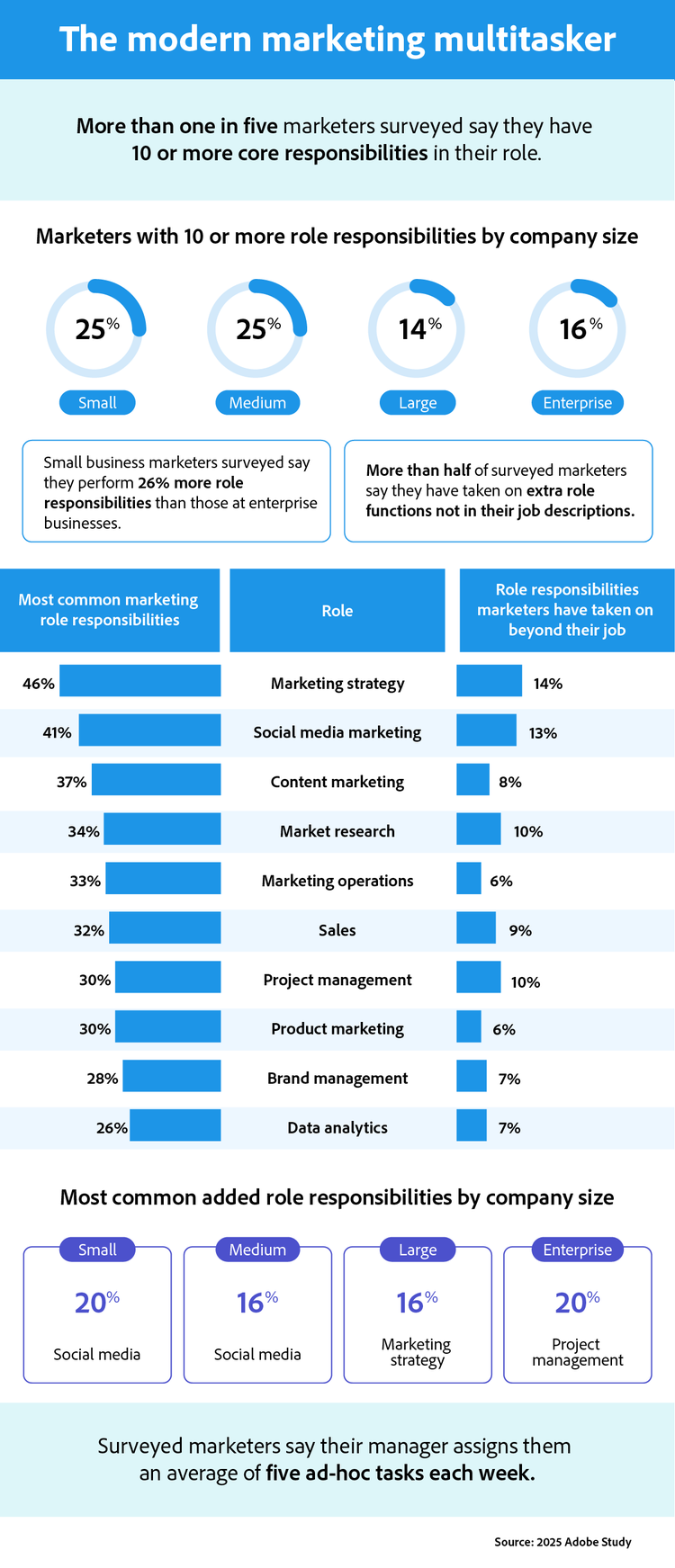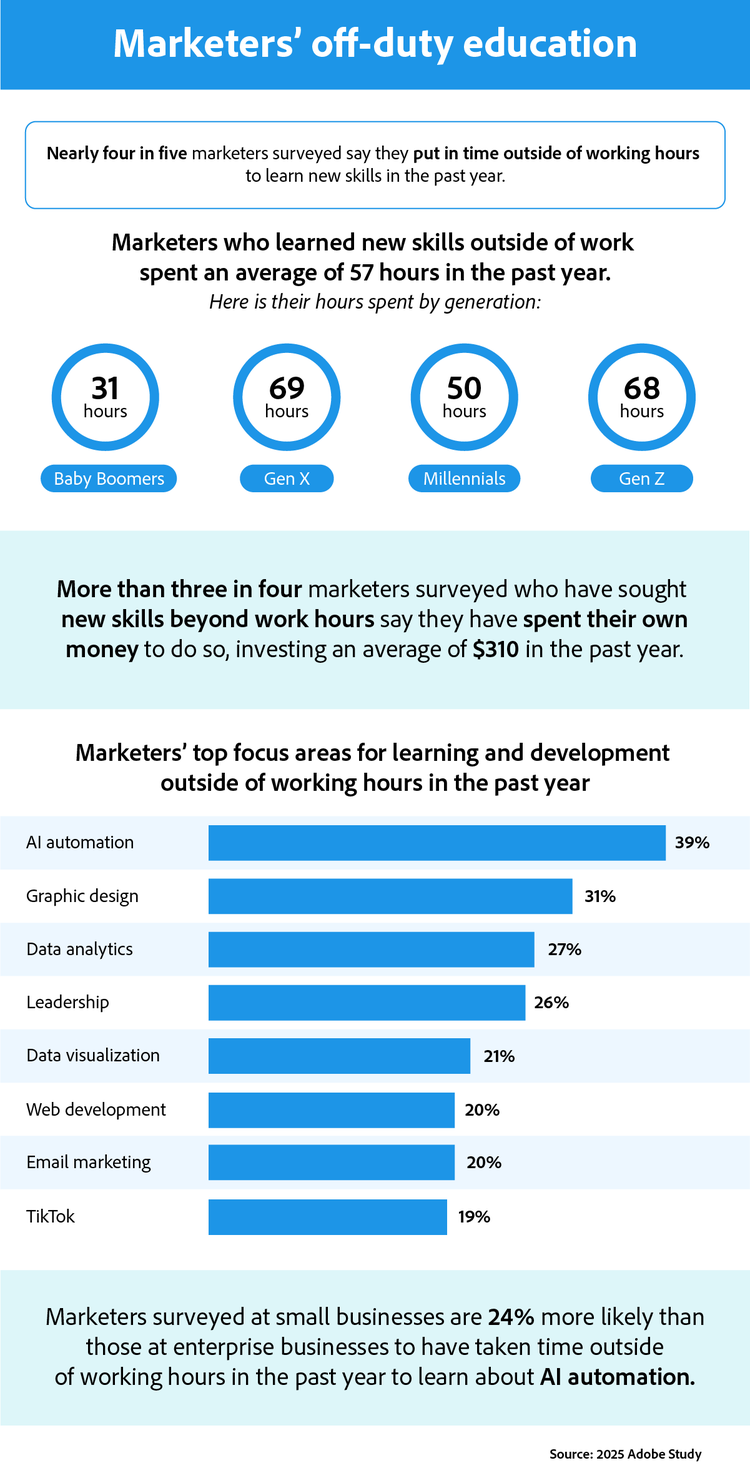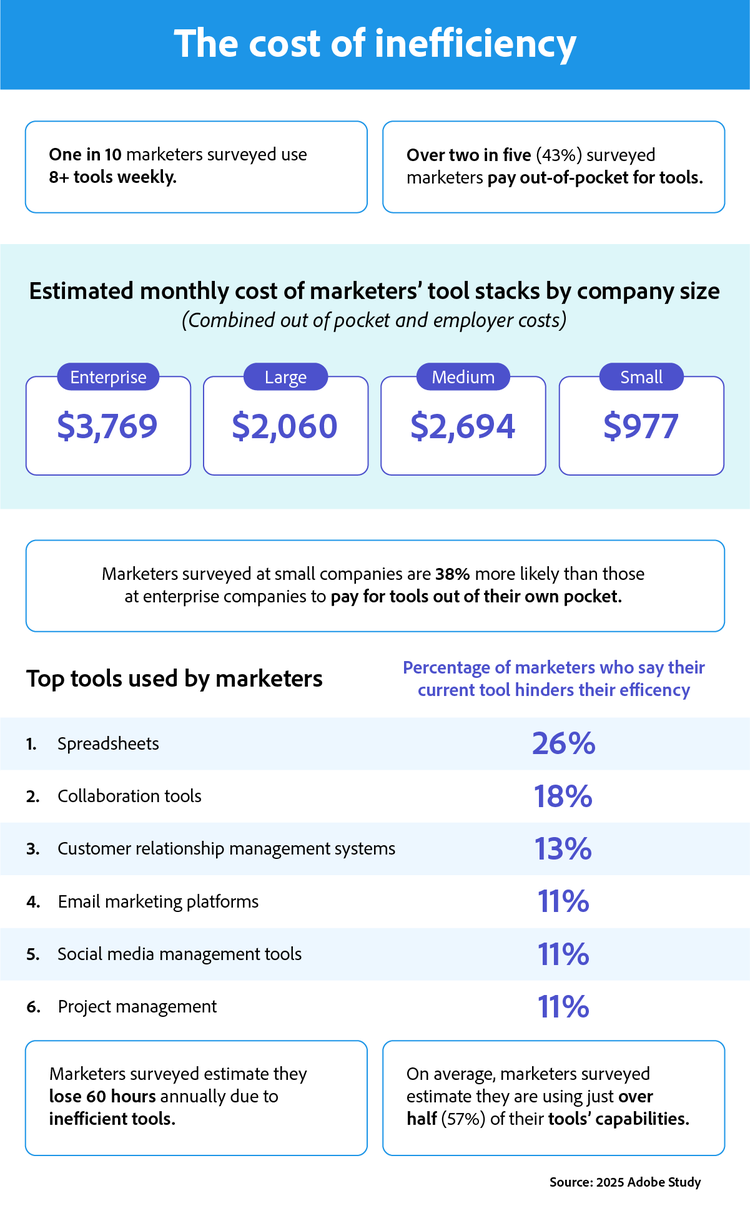
Content marketing is a strategic business approach that uses digital assets (like text, images, and video) to attract and retain a defined audience. It creates long-term value by building trust, deepening engagement, and guiding prospects through the customer journey.
This post will cover:
- What is content marketing?
- Why is content marketing important?
- The demands of content marketing.
- Types of content marketing.
- How to build a content marketing strategy.
- The role of a content marketer.
- What is content marketing personalization?
- Tool inefficiencies and marketing complexity.
- Empower your content marketing with Adobe Experience Manager,
What is content marketing?
Content marketing is a strategic approach that uses educational, engaging, or inspiring content to attract and retain an audience. Unlike traditional advertising, it focuses on delivering value before asking for a sale — building loyalty across every stage of the customer journey. Content marketing assets come in four basic forms:
- Written: Digital newsletters, articles, and blogs.
- Audio: Podcasts, audiograms, and voice assistants.
- Video: Self-hosted content, social media (YouTube, TikTok, reels), and embedded advertising units.
- Image: Social media posts, infographics, or website banners.
Most businesses use several forms of content to engage with their audiences across platforms like social media, websites, and streaming platforms. Campaigns are often muti-channel and personalized — Spotify Wrapped, for example, is a shareable, user-generated campaign that blends data storytelling with platform-native content.
Why is content marketing important?
Content marketing improves brand visibility by delivering valuable, relevant information where your audience is already spending time. When brands demonstrate empathy and expertise — especially by addressing known pain points — customers are more likely to engage with product-specific content like demos, reviews, or case studies.
In an era of constant advertising noise, customers are fatigued by irrelevant messages. Thoughtful content marketing flips the model — instead of interrupting, it invites. It puts the customer at the center of the brand story.
The benefits of content marketing.
Beyond audience engagement, content marketing also delivers measurable business value. Here are some of the key benefits enterprise teams can expect:
- Build credibility through trusted leadership.
- Improve SEO performance and increase organic visibility.
- Guide customers toward conversions with timely content.
- Reduce churn by deepening post-sale engagement.
- Adapt quickly to market and customer behavior trends.
- Lower acquisition costs through efficient reuse and personalization.
What’s more, content marketing continues to grow in strategic value. Enterprise teams are scaling production, personalizing delivery, and automating workflows to stay ahead.
The demands of content marketing.
While strategy sets the direction, executing content marketing at scale is increasingly complex. Enterprise content marketers today must balance personalization, production timelines, and cross-functional collaboration — all under tighter budgets and shifting priorities.
Adobe recently surveyed over 400 marketers to better understand how these demands are impacting day-to-day operations:

- Over 20% of marketers wear ten or more hats in their roles.
- 54% take on responsibilities outside their job descriptions, including strategy, social, and project management.
- Nearly 80% dedicate time outside work to learn new skills, especially in AI automation (39%).
- 43% pay out-of-pocket for tools.
- 60 hours are lost annually due to inefficient tools.
With nearly four in five marketers spending personal time and money outside of work to build new skills, the survey showed that AI automation, design, and analytics are the areas today’s professionals — across generations and industries — see as most valuable to develop.

These findings underscore a deeper truth — fragmented tools and overextended teams can’t support modern content strategies. What’s needed are integrated systems that support the entire content supply chain — from planning and asset management to delivery and measurement.
Types of content marketing.
Despite operational challenges, content marketing remains essential for engaging audiences across the funnel. The key lies in choosing the right content types for your goals and distribution channels:

Blogs
Best for: SEO, education, thought leadership
Blog content helps brands attract organic traffic, share insights, and build credibility. It’s one of the most versatile and cost-effective forms of content marketing. To drive impact:
- Focus each post on a single, well-defined topic.
- Use structured formatting (headings, bullets, short paragraphs).
- Mix short- and long-form content to address different user intents.
- Optimize for search engines and internal linking.
Well-executed blog content supports all funnel stages — from awareness to conversion — and often acts as a source for repurposing into other formats.
Video
Best for: Product demos, brand storytelling, customer engagement
Video content is highly effective for communicating complex ideas, evoking emotion, and driving conversions. Short-form videos on platforms like TikTok, YouTube Shorts, and Instagram Reels are ideal for social distribution, while longer videos can power product pages or campaign landing pages. Use video to:
- Show product features in action.
- Capture customer testimonials.
- Announce new offerings or initiatives.
- Humanize your brand through behind-the-scenes or team spotlights.
With proper planning, a single video can fuel multiple derivative assets — social clips, blog embeds, email snippets, and more.
Podcasts
Best for: Building trust, long-form storytelling, niche audiences
Podcasting allows brands to connect through audio-first storytelling. Branded podcasts can explore industry trends, customer stories, or thought leadership topics in a conversational format. You can:
- Launch your own series to engage a loyal following.
- Appear as a guest on relevant third-party podcasts to expand reach.
Podcasts are especially effective in industries where commuting, multitasking, or screen fatigue are common — think B2B, tech, finance, and education.
Social media
Best for: Real-time engagement, community building, content amplification
Social media content supports awareness and engagement at scale. Brands use platforms like LinkedIn, X, Instagram, Facebook, TikTok, and Pinterest to share updates, interact with followers, and drive traffic. Smart social content:
- Adapts to each platform’s norms and formats.
- Encourages interaction (polls, questions, challenges).
- Promotes cross-channel discovery (link to blogs, videos, gated assets).
Both organic and paid social content can drive measurable results but consistency, creativity, and timing are key.
Infographics
Best for: Data visualization, quick learning, shareability
Infographics turn complex data or processes into digestible visuals. They’re effective in both B2B and B2C contexts — whether summarizing a research study, explaining a workflow, or highlighting key stats in a campaign. Use infographics to:
- Break down survey results or benchmarks.
- Create product comparison visuals.
- Support long-form content with visual storytelling.
You can also crop infographics into smaller assets for use in social media, emails, or presentations — maximizing their lifespan and visibility. Tools like Adobe Express make it even easier to create quality infographics in less time.
Interactive content
Best for: Engagement, lead generation, personalized experiences
While static visuals convey information quickly, interactive content offers even deeper engagement and insight, especially for B2B experiences that demand personalization. Interactive formats, such as quizzes, calculators, and assessments encourage users to actively participate. These tools collect valuable insights and can guide prospects toward relevant solutions. Examples include:
- ROI calculators for enterprise buyers.
- Product selectors for e-commerce shoppers.
- Skills assessments for professional training.
Interactive content bridges marketing and experience, and is especially useful for personalized content journeys.
How to build a content marketing strategy.
Selecting formats is just one part of the equation. To succeed, brands need a strategic framework to guide content creation, delivery, and measurement. To create an effective content marketing program, you need a plan that aligns your audience insights, messaging goals, and delivery channels. Here's how to build a strategy that drives measurable impact:
Define your audience.
Start by understanding who you're trying to reach. Develop customer personas based on roles, behaviors, industry, demographics, and preferences. These personas help you tailor content to meet the needs and interests of specific customer segments — and identify where and how to engage them.
Map content to the sales funnel.
Organize your content to align with the three core stages of the customer journey:
- Awareness, where customers are discovering a challenge or opportunity. Use educational content like blog posts, thought leadership articles, or explainer videos to build trust and inform.
- Consideration, where customers are evaluating solutions. Provide content that offers guidance — such as how-to articles, infographics, or webinars — while lightly introducing your value proposition.
- Decision, where customers are close to converting. Focus on product-centric content like customer testimonials, comparisons, demo videos, or targeted ads to influence their decision.
Choose the right content approach.
Select media styles that match your audience’s consumption habits and your campaign goals. For example:
- Use short-form video or reels for product teasers.
- Publish blogs for SEO and education.
- Share infographics to visualize data or summarize concepts.
- Explore podcasts or webinars to build thought leadership.
Repurpose content across channels to maximize reach and efficiency.
Set clear goals and KPIs.
Establish specific performance metrics tied to your business objectives. Common key performance indicators (KPIs) include:
- Engagement (views, likes, comments, shares)
- Conversion rate
- Organic traffic growth
- Email signups or lead form submissions
Choose KPIs that reflect the intent of your content, and track consistently across platforms.
Plan your distribution.
Even the best content needs the right delivery strategy. Consider:
- Owned channels: Blogs, email newsletters, social accounts
- Earned channels: Backlinks, PR, guest features
- Paid channels: Sponsored content, retargeting ads
Distribute content where your audience already spends time — and tailor format and messaging to fit each channel.
Measure and refine.
Review performance regularly to identify what resonates and what needs adjustment. Use insights to optimize future content, reallocate budget to top-performing formats, and fine-tune messaging for better results.
The role of a content marketer.
Executing a content strategy requires more than just a plan — it requires skilled professionals who can bring content to life across channels. Content marketers make that happen by planning, creating, distributing, and optimizing content that supports marketing and business goals. They combine creativity with data-driven decision-making to execute high-impact content strategies. Key responsibilities include:
Content creation and storytelling.
Develop high-quality, relevant content in various formats — blogs, social posts, infographics, video scripts, and more. Strong writing and editing skills are essential for communicating value and maintaining brand voice.
Audience analysis and SEO.
Use analytics and research tools to identify audience needs, track content performance, and uncover search trends. Apply SEO best practices to improve visibility and expand reach beyond your owned channels.
Campaign strategy and collaboration.
Design content plans that align with broader marketing objectives. Work cross-functionally with designers, product marketers, sales teams, and leadership to ensure content supports campaign goals.
Performance measurement and adaptability.
Track KPIs, assess impact, and iterate based on results. Great content marketers respond to shifting market conditions and platform trends — testing new formats, technologies, and channels to stay relevant.
What is content marketing personalization?
As marketers build and distribute content, personalization plays a critical role in ensuring each interaction feels relevant and timely. Content marketing personalization is the practice of tailoring content to individual users or audience segments based on real-time data. Instead of taking a one-size-fits-all approach, personalized content increases relevance, improves engagement, and accelerates conversions.
Key data signals used to personalize content include:
- Role, industry, job title
- Past behavior (site visits, downloads, purchase history)
- Location and event relevance
- Demographics and declared preferences
Personalization helps marketers deliver the right message, at the right time, through the right channel.
Examples:
- A software vendor might share cloud migration best practices with a CIO researching enterprise transformation.
- A regional retailer might promote upcoming in-store events only to customers in that ZIP code.
When paired with tools like Adobe Experience Manager, personalization can be automated at scale — ensuring every user interaction is as timely and relevant as possible.
Tool inefficiencies and marketing complexity.
Yet even with a sound strategy and team in place, many marketers still face internal friction due to disjointed tools and workflows. Enterprise marketers report tool overload and inefficiency as major barriers. One in ten uses eight or more tools each week — but taps into only 57% of their capabilities. The result? Lost productivity and fractured workflows.
Top pain points:
- Spreadsheets (26%)
- Collaboration tools (18%)
- CRM systems (13%)
Surveyed marketers estimate losing up to 67 hours annually due to inefficient tools, especially in larger organizations. Many are covering tool costs personally. Small business marketers are 38% more likely to do so than enterprise peers.

Survey methodology.
Adobe’s survey of 402 US marketers conducted with a 95% confidence level and a 5% margin of error. Respondents self-reported their experiences; responses may not reflect actual behavior.
Empower your content marketing with Adobe Experience Manager.
Addressing these challenges requires the right technology — one that unifies planning, creation, and delivery into a seamless experience. Adobe Experience Manager empowers marketers to personalize, manage, and deliver content across every channel — faster and at scale.
From digital asset management in Adobe Experience Manager Assets to website creation with Adobe Experience Manager Sites, Adobe’s connected ecosystem helps teams drive efficiency, consistency, and impact. Take your content supply chain to the next level with generative AI on Adobe GenStudio for Performance Marketing.
Ready to scale your content marketing program? Watch the Adobe Experience Manager overview video to see how you can centralize assets, personalize content, and accelerate production across every channel.
Recommended for you
https://business.adobe.com/fragments/resources/cards/thank-you-collections/experience-manager-sites

